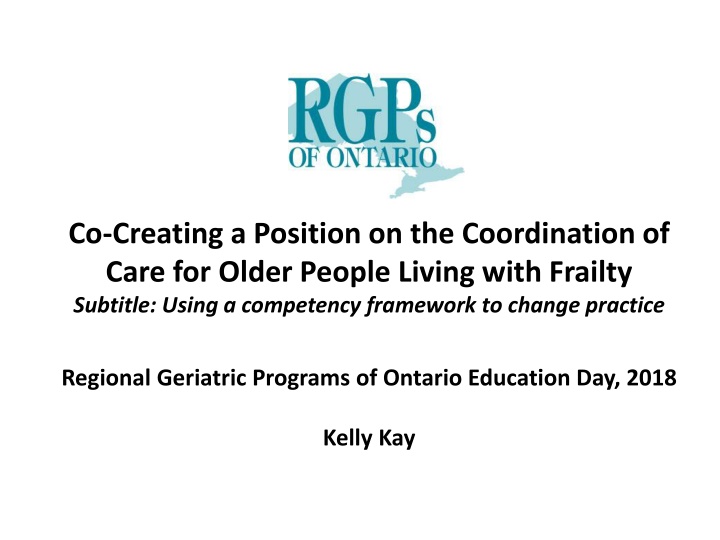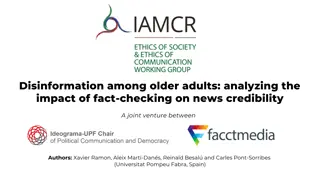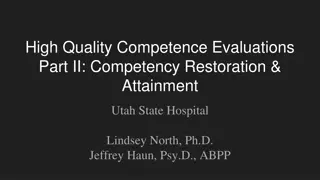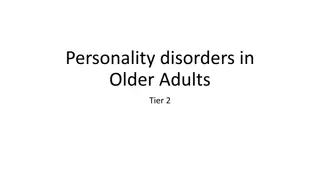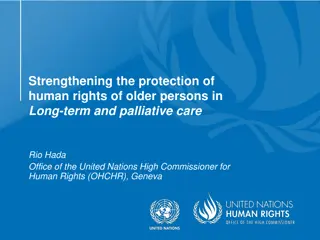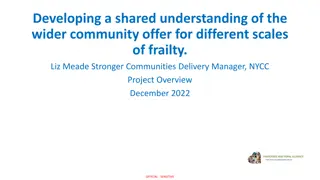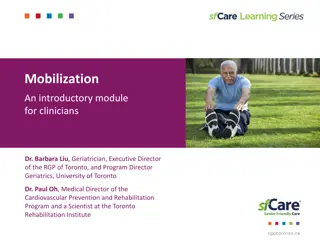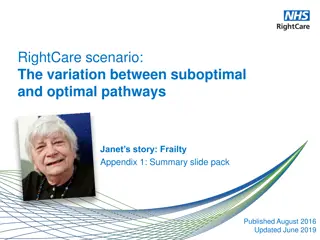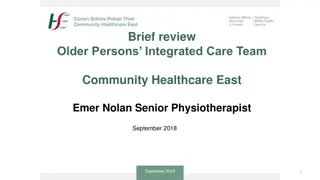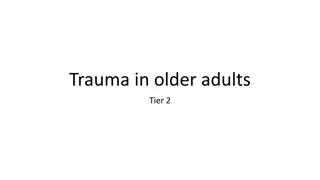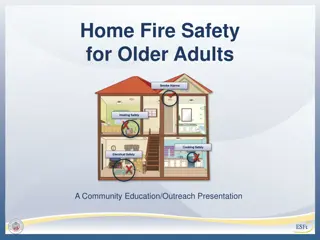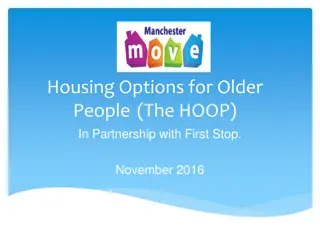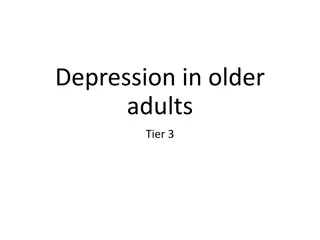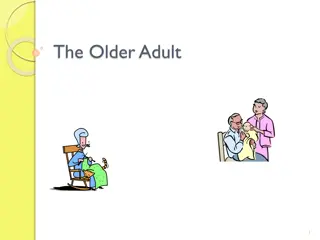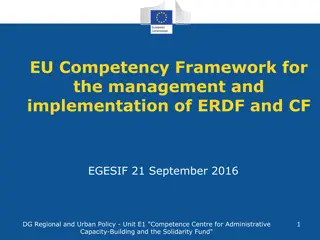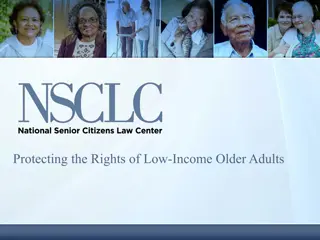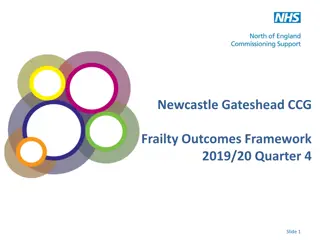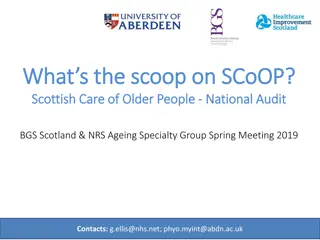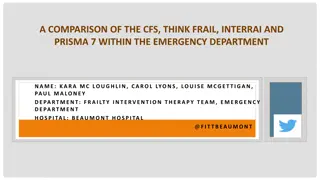Enhancing Care Coordination for Older Adults with Frailty: A Competency Framework Approach
Addressing the challenges in coordinating care for older individuals living with frailty, this initiative focuses on implementing a competency framework to improve interprofessional practice in Ontario. The project aims to enhance geriatric assessment skills, promote a primary geriatric assessor model, and elevate the capacity of healthcare teams in providing comprehensive care for seniors.
Download Presentation

Please find below an Image/Link to download the presentation.
The content on the website is provided AS IS for your information and personal use only. It may not be sold, licensed, or shared on other websites without obtaining consent from the author.If you encounter any issues during the download, it is possible that the publisher has removed the file from their server.
You are allowed to download the files provided on this website for personal or commercial use, subject to the condition that they are used lawfully. All files are the property of their respective owners.
The content on the website is provided AS IS for your information and personal use only. It may not be sold, licensed, or shared on other websites without obtaining consent from the author.
E N D
Presentation Transcript
Co-Creating a Position on the Coordination of Care for Older People Living with Frailty Subtitle: Using a competency framework to change practice Regional Geriatric Programs of Ontario Education Day, 2018 Kelly Kay
Objectives Provide a brief overview the competency framework for interprofessional CGA Demonstrate how a framework can be applied to advance practice locally and provincially through the example of coordination of care with older people living with frailty 2
Overview of the Competency Framework for Interprofessional CGA 3
Background No clear understanding by the interprofessional team of the meaning and components of CGA that they could effectively contribute to Lack of undergraduate and post graduate programming dedicated to development of the skills of geriatric assessment in the interprofessional team findings supported by a meta summary1 of training needs assessments relevant to senior care Varying levels of geriatric expertise not well identified during the hiring process (no competencies against which to measure or even to support the development of appropriate postings) Desire to promote a primary geriatric assessor model one skilled clinician conducting the majority of the CGA 1. Ontario Simulation Network. 2015. Needs assessment meta-summary priority learning needs and practice challenges of health care providers supporting seniors aging at home. 4
Project Achievements Develop and articulate a shared philosophical approach to comprehensive geriatric assessment Confirm the domains of assessment to be routinely included in assessment activity Identify the competencies associated with effective assessment in each domain (the Framework) 5
This Work IS A response to a need for clinical consistency and system wide capacity development A mechanism to optimize the role of the IP team as effective geriatric assessors IS NOT A new reductionist checklist or form that eliminates the need for critical thinking 6
Process of Conducting the CGA The listed domains are those to be included within the Interprofessional Comprehensive Geriatric Assessment and Interventions (CGA). Due to complexity of the target population, each patient has very different concerns. Therefore, each domain should be considered/screened at minimum (i.e., scanning ) and as concerns are identified the interprofessional team then conducts further assessment within the domain. 8
The CGA Process Screen Trigger In-Depth Assessment 9
Ninety-nine (99) behavioural statements vetted through rigorous consensus process Six (6) practice areas Intended to build on profession specific competencies and interprofessional competencies (CIHC, 2010) Can be downloaded from: http://seniorscarenetwork.ca/wp-content/uploads/2017/09/2017- CGA-Competencies-Framework-FINAL-Report.pdf 12
Activities Arising from The Framework Development of a self-assessment tool to enable health professionals evaluate their learning needs related to Interprofessional Comprehensive Geriatric Assessment Development of a compendium of educational resources to support competency development across each domain Identification of practice areas needing further explication and co-design of solutions for policy and practice (today) 13
Today A practice area needing further explication and co-design solutions for policy and practice care coordination. 4.r) Demonstrate the ability to promote integrated care of older patients, especially those with complex needs, and ease transitions across the variety of settings where they may receive services. 4.s) Identify the role of specialized geriatric services in providing case management for the frail senior. (Competency Framework for Interprofessional CGA, p. 11). How would you do this? 14
In This Session Move from a broad framework to address a challenging aspect of practice and pressing policy issue Share insights from a local exploration into team- based coordination of care with older people living with frailty Challenge our current thinking about what and how as it relates to coordination of care Engage with the wisdom of the room to re-define the what and how of coordination of care among older people living with frailty 15
Questions for Reflection Is there a difference between case management and care coordination? What do SGS providers do already (local)? What do older people living with frailty actually need? What does the SGS community believe are key aspects of care coordination that are unique for older people living with frailty? What should care coordination look like and how should it be operationalized? Is this even my job? 16
The Difference a Letter Makes - Case Management and Care Management case management is the process of assessment, planning, facilitation, care coordination, evaluation, and advocacy for options and services to meet an individual's and family s health needs through communication and use of all available resources to promote quality and the most cost-effective outcomes. (p. 139) Osman, A. (2016). Disease management, case management, care management and care coordination: A framework and a brief manual for care programs and staff. Professional Care Management, 21(3), 137-146. 17
The Difference a Letter Makes - Case Management and Care Management care management, sometimes called care coordination, encompasses the many roles that case managers have also, it includes managing individuals beyond a specific episode or situation and providing them with a wide spectrum of services directed at behavioral change, healthy life styles, and optimal outcomes that last beyond the episodic nature of the health encounter. (p. 139) Osman, A. (2016). Disease management, case management, care management and care coordination: A framework and a brief manual for care programs and staff. Professional Care Management, 21(3), 137-146. 18
Is this even my job? SGS plays a role in case management the episodic functions of care planning, coordination and implementation that result from SGS work SGS links with care management functions and system players, more or less effectively The hypothesis - if we can better define and understand our role in case management, we can better contribute to coordinated care for older people living with frailty 19
What do older people with frailty need and what do SGS providers do? An example 20
What do older people with frailty need and what do SGS providers do? Examine an example from the Geriatric Assessment and Intervention Network (GAIN) QI project examined charts of 38 patients from 8 community teams to: To identify the clinical and personal characteristics of older adults living with frailty who require case management as an intervention in their care. To describe the intervention of case management as it relates the care of older adults living with frailty. To identify the team functions and actions that constitute case management for older adults living with frailty. To determine a mechanism to enact case management for the older person living with frailty in the interprofessional team context. Analysis of chart information led and largely completed by Stacey Hawkins, Director Planning, Implementation and Evaluation, Seniors Care Network (the impressive slides are her work!). 21
Background In early 2017, GAIN team managers rejected a HCC (then CCAC)-developed case management approach for GAIN. GAIN managers argued that the document describing case management in GAIN, prepared by Home and Community Care staff, did not accurately describe the case management requirements of the frail seniors in the care of their interprofessional geriatrics teams. GAIN managers were unable to articulate an alternative case management model, but expressed an acute sense of wrongness with the HCC attempts to describe the GAIN teams experience. GAIN managers were challenged by their regional leadership to describe an alternative model of case management that better reflected: the on-the-ground experience of older people living with frailty in the Central East LHIN the specific related functions and actions of community-based interprofessional geriatrics teams who were providing ongoing support to this population 22
Early Thinking: Intensiveness (in Case Management) Is a response to Need for diverse care strategies and interventions Complexity Need for frequent check ins to manage high risk Frailty Need for continuous re-assessment, planned follow-up, trial and evaluation of innovative ideas, trouble shooting Uncertainty 23
Experienced Based Definitions GAIN Case Management* A team-based intervention in which all team members participate. Advocates on behalf of patient and family (empowered by patient and family to act on their behalf) to secure services, make applications, negotiate access Rallies other providers/services (internal and external) to participate in the patient s care plan Assists with navigation of transitions (including transitions back to country of origin in some cases) May include end of life care, in collaboration with available palliative services *Based on GAIN Operating Manual and Discussion with Case Management WG Jan 23, 2017 24
Experienced Based Definitions GAIN Case Management* (cont.) Considers the impact of frailty and dementia, which requires unique, individualized approaches to: Introduction of services (e.g. dementia-aware processes needed for PSW and home help, blister packages) Ancillary supports (e.g. navigating access for patient who cannot open their own doors, securing lock boxes and arranging secure access arrangements) Inclusion of available care partners, or acknowledgement of special considerations required for patients without caregivers/family. Empowered to act on clinical or psychosocial red flags Linkages to primary care to coordinate implementation of interventions *Based on GAIN Operating Manual and Discussion with Case Management WG Jan 23, 2017 25
Chart Review - Process A retrospective chart review was conducted in March 2017. Teams were asked to select a consecutive three month period between January 1, 2016 to December 31, 2016 in which their team had optimal staffing (i.e. most positions filled) and identify five patients who were newly added to the team s Intensive Case Management (ICM) roll/list during this period AND who remained on ICM for a minimum of three months The purpose was to gather patient characteristics (e.g. reason for visit, diagnoses, goals) and team actions (e.g. interventions, recommendations, visit frequency) and other data (e.g. length of stay, ED visits, LTC application, caregiver burden) for patients that team members had designated as intensive case management (ICM). 26
Chart Review Analytic Approach Analysis has focused on comparing and contrasting the intuitive designation of ICM across multiple interprofessional geriatric teams to determine common patient characteristics and team functions/actions that might better define case management for the older patient living with frailty. N=38 27
Chart Review Findings Mean age of patients was 80 years old Age Group Percentage (%) Average number of reasons for referral was 3.4, with the majority of referrals due to concerns regarding cognition (20.8%). 2.6 Under 65 Patients had on average 4 concurrent categories of diagnoses, with the majority of patients (21.6%) being referred with an established diagnosis of cognitive impairment/dementia 15.8 65-74 60.5 75-84 21.1 85 and Older 29
Chart Review Findings Range between 1 and 11 significant diagnoses 25 of 38 patients had one or more vascular related diagnoses (e.g. HTN, CVA, A-fib etc.) 15 of 38 patients had a mood or psychiatric disorder with depression and anxiety being most common 11 of 38 patients had one or more pain related diagnoses (e.g. chronic back pain) 9 of 38 patients had diabetes 9 patients had sensory loss 7 had vision impairment, 2 had hearing impairment (and of these patients one had both) 30
Chart Review - Findings Frequency of Major Dx Among GAIN ICM Patient Sample 50 45 Dementia 40 MCI Vascular 35 DM 30 COPD/Asthma OA/RA 25 Pain 20 Psych Parkinsons 15 Vision impairment 10 Hearing Loss 5 0 31
Chart Review Findings Average length of stay (LOS) was 199 days (SD=99). Ranged from 20 to 580 days LOS (# days) Percentage (%) 2.6 1-49 50% of ICM patients had a LOS of 175 days or greater. Of these, the majority had a CFS greater than 6 (moderately frail). 10.5 50-99 13.2 100-149 31.6 150-199 Average Clinical Frailty Scale (CFS) was 6.0 (Moderately Frail) 23.7 200-249 5.3 250-299 Average Dementia Score (i.e. Global Deterioration Scale) was 4.8 (mild to moderate dementia) for 30 patients 7.9 300-349 5.3 350 and greater Of the 30 patients with a dementia diagnosis, 17 had a specific type identified 32
Chart Review - Findings Visits Average of 8 interprofessional team members involved, with the majority of visits/encounters by the GAIN/HCC Care Coordinator (a nurse case manager role unique to GAIN) (23.7%), PSW/CSW (20.1%), and the Social Worker (18.0%) Teams documented between 1 and 121 visits per patient during the time period 50% of ICM patients received 33 or more visits 25% of ICM patients received more than 50 visits. Of those patients receiving the highest frequency of visits, the majority (7 of 11) required 10 or more interventions by the GAIN team. Visits can include in-person or telephone calls of a substantive nature 33
Chart Review Findings MEAN LOS (# days) GDS Score CFS Score # Interventions # Clinicians 2 350 and greater 5 9 7 (age-associated memory impairment) (mildly frail) 5 6 12 6 300-349 (moderate dementia) 6 (moderately severe dementia) 5 (moderate dementia) (moderately frail) 8 10 5 250-299 (very severely frail) 6 6 5 200-249 (moderately frail) 5 6 9 5 150-199 (moderate dementia) (moderately frail) 4 6 8 5 100-149 (mild dementia) 5 (moderate dementia) 5 (moderate dementia) (moderately frail) 6 (moderately frail) 8 (very severely frail) 11 6 50-99 1 2 1-49 34
Chart Review Summary of Patient Characteristics Patient charts included in the review typically indicated that ICM patients are: referred to GAIN for multiple reasons, most often for complex concerns related to cognitive decline living with multiple, concurrent diagnoses, the majority of which include an existing diagnosis of a dementia Moderately Frail (CFS=6) Require assessment/intervention by the majority of the GAIN interprofessional team Being followed by the team to address multiple interventions/recommendations Not being discharged from ICM If discharged, most move to higher level of care (LTC) However, there are no clear patterns or significant differences between the variables collected during the chart review that explain the patient s LOS on ICM No clear patters between higher CFS and LOS, number of interventions or visit frequency by team members 35
Team Functions/Actions/Recommendations (n=325) Frequency of GAIN Recommendations by CGA Theme 70 Further Ax/Referral 65 Medical/Surgical 60 Medication Social Mood/Mental Health 50 Cognition 47 Function Falls 40 41 Sleep Pain 30 Nutrition 30 29 Continence Safety 24 20 Caregver Support 19 Capacity 17 16 15 15 LTC Application 13 10 Advanced care directives 10 Other 6 5 37 4 1 2 0
Further Ax and Referral Sample Team Functions/Actions/Recommendations Bloodwork/ECG (5) MRI/CT (3) Diabetes management Referred to Respirologist for PFT Attend GI specialist (assist with transportation and have PSW accompany) Referral to dietitian for sarcopenia and appetite Referral to geriatric psychiatrist/PASE (2) Joint visit with podiatry at home Liaise with GP and family health team regarding patient s physical and social issues. Possible psycho-geriatrician referral. Convalescent care application (restorative goal) Referral to headache/pain clinic. ED visit as in heart failure Frequent updates, and ongoing assessment several times per week Endocrinologist CNIB Referral/Joint Visit (6) Alzheimer Society Referral/Joint Visit (3) Dentist Assessment with geriatrician Note to family MD and Cardiologist re: pain management and prognosis with CHF She will also be referred to medical genetics. F/U in GAIN (2) Hearing society Vascular Lab and consultation Referral to Cardiologist Referral to wound specialist Consult with hospital staff Assess & Restore 38
Social Sample Team Functions/Actions/Recommendations Organizing finances and paperwork Referred to PGT, arrangement of medical appointments and transportation application Capacity assessment re: Finances Fraud/financial abuse (3) Referral to Adult Day Programs (10) Arrange transportation Funding application for equipment Social supports and community services (3) Organizational strategies/cognitive supports (2) PSW GAIN hours for companionship/social support (4) Referral to GAIN SW for motivational interviewing GAIN ICM (2) Meals on Wheels PSW services started to assist with personal care, monitor patient s general condition and report concerns, provide social interaction. Family dynamics (2) Monitoring well-being/care plan support (GAIN) (3) Redirection (e.g. inappropriate ED use) (2) Hardship funding options SW for counselling Referral to ACE/Legal Aid Family check ins Housing support/living arrangements (2) Application for assisted living BSO - meaningful activities, behavioural strategies (2) Support/advocacy to accept/receive in home services (2) Assist to remain at home 39
Caregiver Support Sample Team Functions/Actions/Recommendations Re-assesssment of dementia and stage with a focus on management of behaviors and caregiver stress. Maximize home supports given increasing care needs and responsive behavior (HCC/Day Program/GAIN PSW). Ongoing support and education for caregiver from BSO nurse (assess and help manage responsive behaviours (sundowning)). HCC PSW added for support and medication reminder Connection to community supports (e,g, HCC, the Alzheimer Society and the CNIB) (2) PSW for support to client and caregiver relief GAIN-HCC CC support to spouse- monitor progress All team members provided education to spouse re: Dementia and medication management PSW/SW/GAIN-HCC CC- Provided ongoing emotional support and linking to community programs as needed. 40
Caregiver Support (cont.) Sample Team Functions/Actions/Recommendations GAIN-HCC to visit and monitor coping, discuss LTC application and assess capacity. SW to provide emotional support to caregiver and client. Three separate resources provided for caregiver support Support given to Health care providers that were verbally abused by niece Caregiver support for caregiver distress, referred to support group Respite Care (including in-home) (4) PSW for respite, bathing, light meals and socialization (2) Encourage spouse s self-care as the primary caregiver; especially regular follow-up with his PCP given weight loss/health concerns. A GAIN Coordinated Care Conference was completed with spouse, daughter and the GAIN team (including Risk Management) to ensure everyone was up to date and the care plan was confirmed. Support and encouragement to be willing to accept help HCC referral - PSW support Education counseling for spouse re: Management of responsive behaviors LTC bed offer and how to respond Support family in caregiving given increasing care needs, the plan for MM to die at home and the potential for caregiver stress. 41
Recap Share Your Wisdom Difference between case management and care coordination What SGS providers do already What older people living with frailty actually need Is this our job? 42
Our Task What does the SGS community believe are key aspects of care coordination that are unique for older people living with frailty? What should care coordination look like and how should it be operationalized? Not the role the function! 43
Group Activity: World Caf The Caf is built on the assumption that people already have within them the wisdom and creativity to confront even the most difficult challenges. Given the appropriate context and focus, it is possible to access and use this deeper knowledge about what s important. 44
World Caf: Instructions Four or five people in conversation clusters (roughly 25 clusters). Each group has a host that does not circulate while the others serve as travelers or ambassadors of meaning. The travelers carry key ideas, themes and questions into their new conversations. Two rounds of conversation of approximately 20 minutes each. Addressing questions or issues that genuinely matter 45
World Caf: Instructions Both conversation hosts and members can write, doodle and draw key ideas on paper. Hosts: welcome the new guests and briefly share the main ideas, themes and questions of the initial conversation. Encourage guests to link and connect ideas coming from their previous discussion During conversations listening carefully and build on each other's contributions. After round two a debrief of major themes 46
The Questions Round one: Identify and define two important features /elements/ components that must be part of coordination of care activities focused on older adults living with frailty. Round two: Describe the activities that interprofessional teams in specialized geriatric services ought to carry out to contribute to coordination of care activities focused on older adults living with frailty. 47
The Debrief What discoveries and insights were made? What patterns can be identified? What possibilities for action emerge.? 48
What We Accomplished An overview the competency framework for interprofessional CGA Illustrated how a framework can be applied to advance practice locally and provincially through the example of coordination of care with older people living with frailty Set the stage for an SGS-led position statement on requirements for coordinating care with older people living with frailty which will set the stage for policy and practice in this area 49
In closing If you wish to remain involved as this position statement develops kkay@nhh.ca Thank you for shaping SGS interprofessional practice 50
